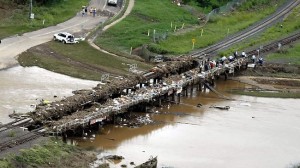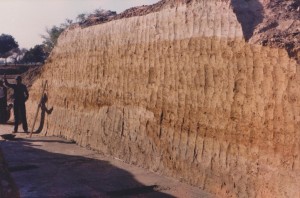The Queensland Premier is calling for a re-construction task of post-war proportions. What is required is not just a re-construction but an adaptation of infrastructure to future climate change because climatologists warn us that global warming means more moisture in the atmosphere over warmer ocean waters and therefore more rain under La-Nina conditions. This means that low embankments and short span bridges for roads and railways have to be re-built for these new rainfall parameters.
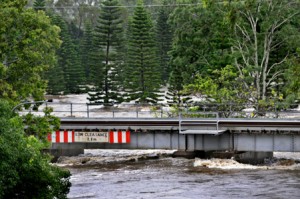 Rail bridge over the Pine river too low
Rail bridge over the Pine river too low
http://city-north-news.whereilive.com.au/photos/gallery/the-deluge-continues/
At the same time there is more evaporation and drought over land in El-Nino situations, impacting on agricultural production and inland power generation (lack of cooling water).
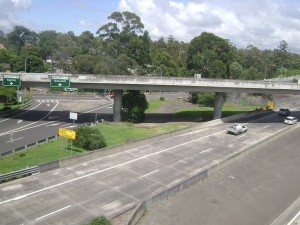 While timber rail bridges in Queensland from the early parts of the last century await re-construction, Sydney’s RTA and Transurban think they can afford the luxury to pull down a bus bridge built just 15 years ago to make room for a 3rd lane on the M2. Contractors scheduled for this unnecessary project should be given much more urgent work in Queensland.
While timber rail bridges in Queensland from the early parts of the last century await re-construction, Sydney’s RTA and Transurban think they can afford the luxury to pull down a bus bridge built just 15 years ago to make room for a 3rd lane on the M2. Contractors scheduled for this unnecessary project should be given much more urgent work in Queensland.
These weather extremes show us what is likely to happen: nature will physically force us to dramatically reduce CO2 emissions, including getting away from coal, much earlier than is generally thought. Last year at a lecture in Sydney Uni, NASA climatologist James Hansen, author of the book “Storms of my Grandchildren”, gave Australia 10 years “to stop their coal”. So there is no need to ramp up coal exports. And replacing coal fired power plants means we have to be very frugal with using electricity, which will preclude the mass-use of electric cars. So there will be a shortage of carbon-free primary energy to replace oil which started to peak in 2005, causing an oil price shock in 2008.
The double challenge of global warming and peak oil means that all these new toll-ways won’t experience growing traffic due to lack of energy and alternative fuels. Ethanol, for example, is already in short supply to implement a mere 10% blend into E10.
So we are getting now one warning after the other to change our investment strategies away from oil and to reduce CO2 emissions. Governments and banks should take this opportunity and work out a financing plan for genuinely sustainable infrastructure to survive the next flood which may coincide with diesel shortages in a period of declining global oil export volumes.
The repair bill for Queensland means there will be little Federal money for expensive rail tunnels in Sydney. The M2 and M5 widening should be replaced by a much cheaper, more efficient and oil independent Transperth solution and the funds thus saved could be used in ”Queensland Reconstruction Bonds”
Excursion into flood-prone Bangladesh: Having worked 5 years to build up infrastructure for an agricultural project there I know only too well what flooding means.
 Rural feeder road to connect main highway with new irrigation area (it is bone dry between January and March). High embankments and many culverts are the only solution to flooding during the monsoon season.
Rural feeder road to connect main highway with new irrigation area (it is bone dry between January and March). High embankments and many culverts are the only solution to flooding during the monsoon season.
Deep drop walls for abutment and wing wall foundations stop scouring. Huge challenge in clay soils.
The response of nature to higher CO2 hits the coal industry itself, one of the main emitters.
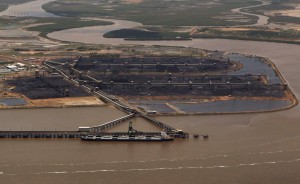 Tanna coal terminal in Gladstone impacted by floods. The additional $ 5 bn Wiggins coal terminal approved by rock star Peter Garrett when he was “Environment” Minister is located to the right.
Tanna coal terminal in Gladstone impacted by floods. The additional $ 5 bn Wiggins coal terminal approved by rock star Peter Garrett when he was “Environment” Minister is located to the right.
Scientists see climate change link to Australian floods
12/1/2011
“I think people will end up concluding that at least some of the intensity of the monsoon in Queensland can be attributed to climate change,” said Matthew England of the Climate Change Research Center at the University of New South Wales in Sydney. “The waters off Australia are the warmest ever measured and those waters provide moisture to the atmosphere for the Queensland and northern Australia monsoon,” he told Reuters. [Ref…]
7/12/2009 ABC TV Lateline interview:
TONY JONES: …. why worry about carbon dioxide when water vapour is a stronger greenhouse gas and actually occurs naturally?
JAMES HANSEN: Yeah, that’s the screwiest argument which keeps being made again and again and again. The amount of water vapour in the atmosphere is determined by the atmosphere’s temperature, everyone should know that. Look at the difference between winter and summer.
As you go to a warmer climate the atmosphere holds more water vapour because at the places where the humidity reaches 100 per cent the water vapour falls out as water or snow. And therefore, as the planet becomes warmer, the atmosphere holds more water vapour.
That’s why we get heavier rain falls as the planet gets warmer. So this water vapour is an amplifying feedback. It makes the greenhouse effect much stronger. But it’s not something that just changes on its own accord; it changes in response to the temperature changes.
TONY JONES: Okay, if I understand it correctly your argument is that climate change is not only about droughts, but that effect you’re talking about will cause much more frequent and much more severe storms; is that correct?
JAMES HANSEN: Yeah, the, both extremes of the hydrologic cycle must increase, become more intense as the planet becomes warmer. At the times and places where it’s dry, the increased heating of the surface makes it hotter and drier.
On the other hand, the oceans, the places where you have water, the increased heating evaporates more water, so the atmosphere holds more water vapour and at the times when you get rainfall you will get heavier rainfall and greater floods, so the extremes of the climate increase, the extremes of the hydrologic cycle.
Now as far as storms are concerned, the storms that are driven by latent heat – that means thunderstorms, tornados, tropical storms – the strongest ones will get stronger because there’s more fuel. The water vapour provides the fuel for those types of storms.
Not all of them will be stronger, but the strongest ones will be stronger than the strongest ones now. But in addition to that, and one thing I talk about in my book, Storms of my Grandchildren, I’m talking about the mid-latitude storms, the fact that as the icesheets on Greenland and Antarctica begin to melt more rapidly than they are now, they will discharge ice fast enough that it will cool the surface of the ocean, nearby ocean, in the North Atlantic and in the circum Antarctic Ocean.
That will cause the temperature gradient between low latitudes and high latitudes to increase, so the storms that are driven by horizontal temperature gradients will become stronger, and these can be very damaging storms, this is like the storms that hit the Netherlands and England in the 1950s.
They can do enormous damage. So, yes, it’s true that all the storms that we can think of will become stronger as the climate becomes warmer. [Ref..]
8/3/2010
NASA climatologist James Hansen at Sydney Uni:
“Australia doesn’t agree now that they got to stop their coal, but they are going to agree. I can guarantee you that within a decade or so because the climate change will become so strongly apparent that’s going to become imperative”. [Ref..]
httpv://www.youtube.com/watch?v=kYUpkPTcqPY
Events like these will ultimately force us to abandon coal and replace all coal fired power plants, and very fast. There will be little carbon free energy left over to continue our car culture.
The best description of how we produce oil and at the same time undo millions of years of geo-sequestration of CO2 which cooled down planet Earth to a liveable place for human beings can be found in this documentary: The incredible journey of oil http://www.abc.net.au/science/crude/
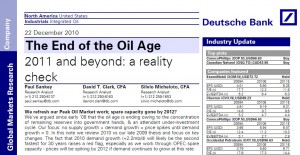 And Deutsche Bank seems to have understood [Ref…]:
And Deutsche Bank seems to have understood [Ref…]:
Summary:
Peak oil and global warming are not topics which can be endlessly debated and ignored. It is now high time that business as usual is stopped otherwise these problems will become more and more physical events which will disturb our lives. The Queensland floods should be taken as an opportunity to re-direct funds from run-of-the-mill toll-way projects to Reconstruction Bonds for Queensland. But not for coal related projects of course.
